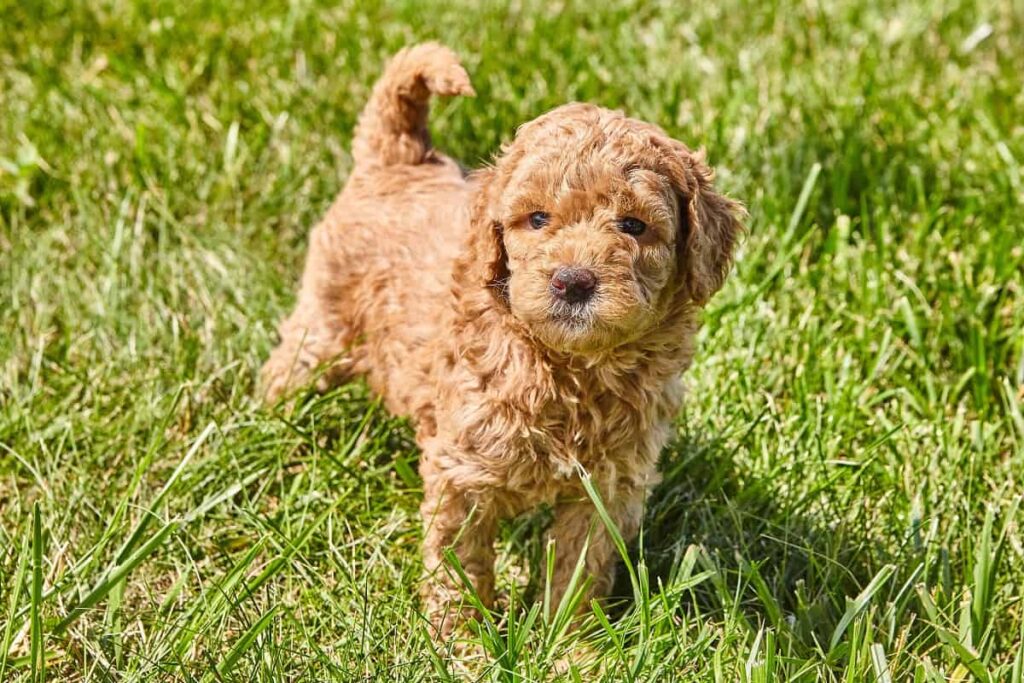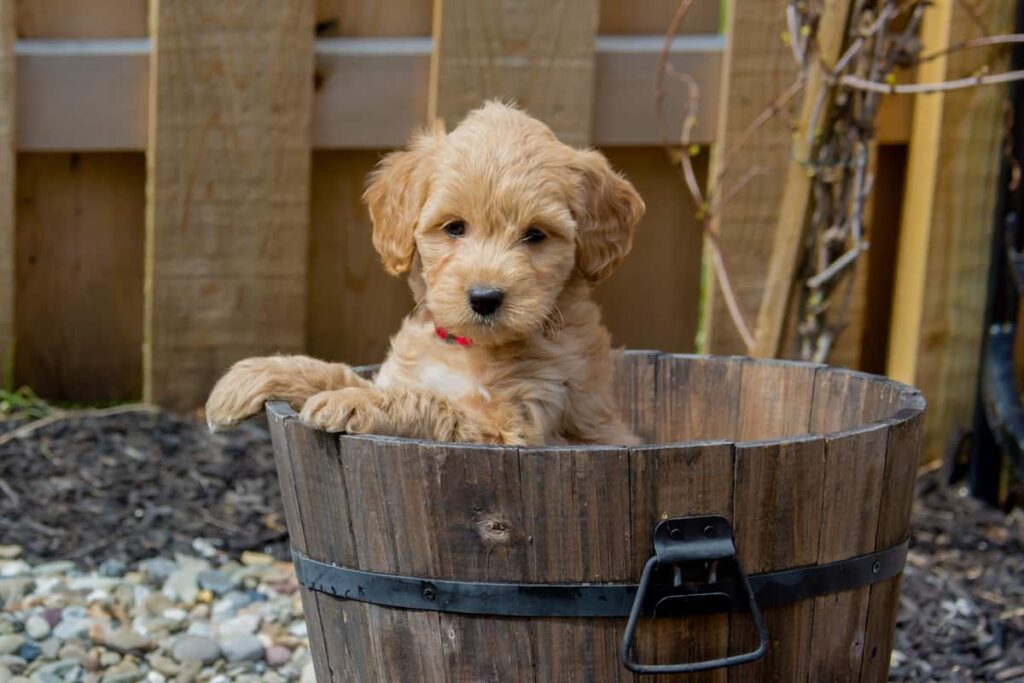Suppose you are looking to adopt a new furry friend into your family, and you’ve been looking at advertisements from different breeders. In that case, you may have noticed that breeders advertise their Goldendoodle breeds as either F1 or F1b.
This would obviously be confusing to someone new to the dog breeding scene. But have no fear because we will explain to you the significance of this classification and explain the differences between these two breeds – the F1 vs F1b Goldendoodle.
What Does “F1” Mean?
F1 is a classification of the generation of Goldendoodles that allows you to identify them quickly. The “F” stands for the world “Filial,” which indicates that the dog is crossbred and not purebred. Because all Goldendoodles are crossbreeds of Golden Retrievers and Poodles, all of them have this letter assigned to them. The number indicates what generation Goldendoodle they are, so F1 Goldendoodles are the first generation crossbred Goldendoodles.
More precisely, an F1 Goldendoodle is also a Goldendoodle that is genetically 50% Poodle and 50% Golden Retriever, meaning that the parent dogs were 100% purebred. Because the Goldendoodle that resulted from these purebreds would be the first crossbreed in their genetic line, we label as F1.

Characteristics of the F1 Goldendoodle
The F1 Goldendoodle is the more popular type of Goldendoodle, but this is mostly because they are the most numerous because of how common Poodles and Golden Retrievers are. As the first generation in their line, they also have the most considerable differences between each other, as there is no telling which set of genes from which parent is the most dominant until after the fact. So if you’re looking to get a first-generation Goldendoodle, be aware that your dog may be entirely unlike any other Goldendoodle out there.
This variance in your Goldendoodle isn’t limited to their personality. Because of the 50/50 nature of their genes, you can never tell how hypoallergenic your furry friend may be or how their coat will look or shed. However, because we know that your Goldendoodle comes from the Golden Retriever and Poodle and shares their genes the most evenly, you can make some reasonable estimates.
Should they be more like their Poodle parent, they will likely have curlier or wavier coats that don’t shed as much and are more hypoallergenic. The opposite can be said should their Golden Retriever genes be more dominant. Their coat is straighter and smoother, shedding more but are less hypoallergenic. Their personalities can be affected too, with Poodle dominance making your pup more intelligent and Golden Retriever dominance ensuring loyalty and affection.
For many, the biggest draw of F1 Goldendoodles is their health. They have a health benefit known as Hybrid Vigor, which is something evident in all first-generation crossbreeds and is a trait that gets weaker as you go down the line.
Hybrid Vigor essentially means that your pet is less predisposed to health complications than their purebred parents, and this is because purebred inbreeding causes many genetic defects. Crossbreeding purebred dogs removes all or most of these genetic defects and only passes on the medical genetic problems Poodles and Golden Retrievers generally suffer from.
So, in short, F1 Goldendoodles are first-generation crossbreeds between Poodles and Golden Retrievers. Because they are first generations, there is no telling which set of genes they inherit will be most dominant, leading to massive variance between each Goldendoodle. They are among the most common Goldendoodles and possess incredibly healthy bodies thanks to their Hybrid Vigor.
What Does “F1b” Mean?
Similarly to F1, the “F” stands for Filial, meaning the dog is a crossbreed, and the “1” indicates that the dog is the first of their generation. The “b” stands for “Backcross.” Backcross means that the Goldendoodle results from an F1 Goldendoodle being backcross bred with a purebred dog of the same breed as their parent, so either a purebred Poodle or purebred Golden Retriever.
The result of this breeding is a Goldendoodle that, instead of being 50% Poodle and 50% Golden Retriever, is 75% Poodle and 25% Golden Retriever. Breeders prefer this mix of genetics with the more dominant Poodle genes because of the Poodle’s non-shedding and hypoallergenic characteristics.

Characteristics of the F1b Goldendoodle
While the F1 Goldendoodle is the most common type, the F1b Goldendoodle is a favorite amongst breeders because it is a way of ensuring your Goldendoodle inherits the Poodle’s hypoallergenic and curly fur that doesn’t shed. This characteristic also makes it more desirable among people looking to become dog owners, especially those with severe allergies.
The only other significant difference between F1b and F1 Goldendoodles is their Hybrid Vigor. Because they are a backcross breed between an F1 and purebred Poodle, their Hybrid Vigor trait is less apparent, as they are technically a second generation Goldendoodle. This follows the pattern of the Hybrid Vigor trait growing weaker as the generations continue.
Otherwise, the F1b Goldendoodle is still very similar to the F1 Goldendoodle in its characteristics, except with a much heavier lean on the Poodle side of the spectrum for their genetics.
The Significant Differences Between F1 and F1b Goldendoodles
Now that we have briefly covered each Goldendoodle breed, let’s make some direct comparisons.
The first significant difference would be in their genetics. F1 Goldendoodles are a straight 50% Poodle and 50% Golden Retriever, while F1b Goldendoodles are instead 75% Poodle and 25% Golden Retriever.
This slight difference means that the random nature of their characteristics’ outcome is less prevalent, with the breeder almost forcing the genetics to follow more closely with the Poodle’s genetics. What this means is that the F1b Goldendoodle is far more likely than an F1 Goldendoodle to be hypoallergenic and shed far less, with their coat being curly or wavy in comparison.
This makes F1b Goldendoodles more popular among those who have allergies or would prefer lower maintenance, as the F1 will be more likely to be less hypoallergenic and shed a lot more. However, the one significant benefit of the F1 is their stronger Hybrid Vigor, as they are first-generation crossbreeds.
While many would choose the F1b over the F1 because of the lack of shedding and hypoallergenic traits, those same owners must be careful to properly take care of their pets so that their fur doesn’t build up and become uncomfortable for them because of mattes and tangling.
It would be best if you also took care to cut their hair every 8 to 12 weeks because of the curlier nature. The F1 Goldendoodle has straighter hair that is more prone to shedding, so you should also take care to clean them regularly as their hair can become quite matted if they are very active pups.
However, should you not mind the shedding, the F1 Goldendoodle has a lot of appeal thanks to their Hybrid Vigor, which means you potentially, in the long run, can save money on vet bills as your Goldendoodle will be healthier than either parent.
Their Hybrid Vigor means they won’t suffer from many of the genetic disorders their purebred Poodle and Golden Retriever parents would, but it, unfortunately, won’t stop them from suffering from medical problems that their purebred parents commonly suffer.
There is also the matter of differences in their personality types. F1b Goldendoodles and F1 Goldendoodles who lean more towards the Poodle side are more intelligent and independent as pets. In contrast, F1 Goldendoodles, who are more like their Golden Retriever parent, tend to be more loyal, friendly, and sociable, as well as more dependent on attention and positive reinforcement.
Keep in mind that F1 Goldendoodles can vary wildly from another as they are first generations. However, there are still some common trends you can observe that they can inherit from their parent dogs, so these are just educated assumptions that can be made based on what we know of their parent breeds.
These personality traits also extend to how you would care for and train them. F1b Goldendoodles, as they are closer to Poodles and are thus slightly more intelligent and independent, can be stubborn and rebellious when trying to teach them, especially when they are still young. However, they can also adapt quickly, and should you train and reward them appropriately, they can learn fast and realize that their training is only good for them.
F1 Goldendoodles are more playful and earnest in nature, and while this doesn’t mean they are less intelligent, it means you might have to approach training them differently. They might view the training as playtime and may take longer to learn new concepts, but with the right approach, you can get them to learn through play.
Final Thoughts
There is actually very little difference between the two fundamentally, with the only significant difference between the two being the different genetic ratios, which has very little influence over their intelligence and temperament.
F1b Goldendoodles are also predictable in their outcome as they are more like their Poodle parent while still keeping much of the Goldendoodle’s characteristics. All in all, they are intelligent, beautiful, and charismatic creatures that make excellent companions and family pets.

